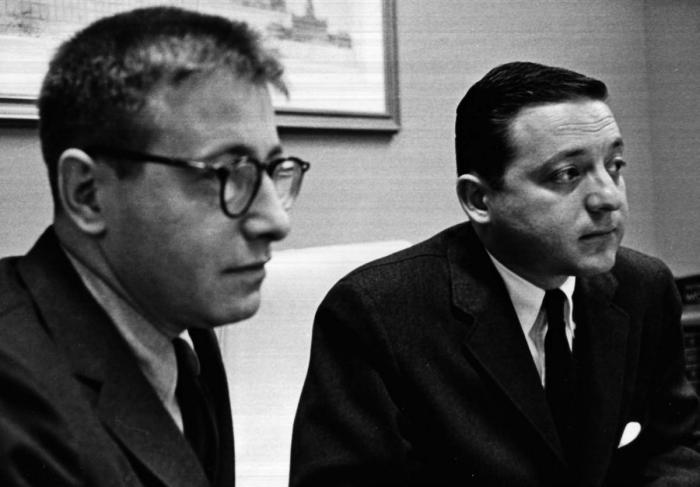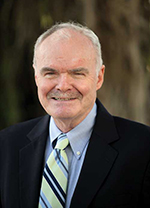
Jimmy Fazio, the late restaurateur who knew how to navigate the rougher waters of life, had just been paid a visit by the cops. This was in Wally's Olde Town Chop House back in the mid-1990s. The place is now called Himmarshee Public House.
The police visit had resulted from a complaint by one of Fazio's business associates.
"They said Mr. M----- said that I had threatened to kill him," Fazio reported. "They asked, 'Did you threaten to kill him?’ I told them, 'No, I never threatened to effin' kill him.' They said, 'Did you threaten him in any way?' I said, 'Yes, I threatened to break his effin' legs.’ ‘Oh,’ they said, ‘That's OK.’ So Bernie, be sure to never threaten to kill anybody, but it's OK to threaten to break their legs.' "
This picaresque tale may be amusing, but it applies to a situation that is anything but funny. It is a defense mechanism to prevent us from writing anything extreme about the punishment deserved by those we consider accomplices to the murder of 17 people in our county last week.
This awful incident was not just close to home. It was home. There are not many people around here who have not been personally affected by the latest mass shooting. In our case, one of Gulfstream Media's oldest and most valued employees, art director Craig Cottrell, had a kid and a nephew at Marjory Stoneman Douglas High School. Thank God they were not victims. His daughter escaped by climbing over a fence.
One of the students killed is the daughter of the lacrosse coach at St. Thomas Aquinas High School, which our grandchildren attend. Another victim was Douglas' cross-country coach, whose team competes against our talented grandsons at St. Thomas.
The anger here is therefore more immediate and personal that any of the other mass shootings. And the accomplices to murder are close enough to be reminded of Jimmy Fazio's advice. They are all the Florida politicians on both the state and federal level who are prostitutes for the NRA. They take campaign contributions which amount to bribes. That money is legal, but it should not be. It is blood money. Some observers have noted that it isn’t all about money. There is also the fear that the NRA will use the same dollars to defeat any candidate it can’t control, and will fund a primary challenge to those who defy it. Either way, the politicians are afraid to cross this organization which is funded by the arms industry.
Sunday’s Miami Herald ran the photos of nine of these politicians, beginning with President Trump, which looked almost like a “Most Wanted” poster. Such condemnation leads to hope that perhaps our local tragedy may prove a tipping point.
"Maybe this time it will be different, maybe this time people will be so angry that something will happen." So spoke our colleague Craig Cottrell, father and uncle of two students at Douglas. We would like to think so, but the early reaction seems to be terribly familiar. The local response has been uniformly admirable. Saturday's Sun-Sentinel caught the mood. There was a lead op-ed piece by Gary Farmer, Broward state senator, calling for gun control. His piece concluded with seething determination:
"As legislators and parents, we will not rest until we can ensure the safety of our children and communities. We will fight tooth and nail against every dangerous and nonsensical pro-gun piece of legislation in the legislature. We will not allow our legislature to act as a contributing factor for the terrifying violence that we saw this week, and we demand that our fellow legislators do the same."
In the same section Broward Commissioner Michael Udine, whose district includes Parkland, wrote "...in addition, we must demand that Congress enact an assault weapons ban that includes AR-15 semi-automatic rifles and further background checks. Any issue whatsoever that comes up in someone's background should be investigated before they can obtain a gun."
Even more telling were nine letters to the editor. One was a short pious "praying for you" thought. The other eight all called for gun control or voting out those paid-off legislators who block sensible laws. There was no sign of the usual second amendment rights BS.
That was here. Elsewhere, the early returns showed the usual NRA lackeys reaction to such tragedies. President Trump made a publicity trip to say this was bad and praised the first responders and health care workers, but there was no mention of gun control. It was more of the same with Sen. Marco Rubio, House Speaker Paul Ryan, State Senate President Joe Negron, who all called for action, especially in the area of mental health and increased school security, but did not touch the obvious problem—the existence of military-style weapons in the hands of anyone except combat troops.
The mental health issue is simply a way of avoiding the truth. And the same Sun-Sentinel page handled that canard beautifully. Surely the young man who confessed to the murders is mentally ill. Steve Ronik, the highly respected CEO of Henderson Mental Health Clinic, whose organization had contact with the shooter, and did not consider him an immediate threat, wrote that the percentage of violent crimes by the mentally ill is very small. He identified the real problem—that the mentally ill can get their hands on the weapons that even the sanest person should not possess in civilian life.
But newspaper articles are not going to solve the problem. And since Jimmy Fazio’s advice to threaten to only break their legs is probably illegal, even in Florida, where do we go from here?
We go back to the west of Ireland, 1880, when Charles Parnell suggested to angry Irish who wanted to kill a hated landlord, Charles Boycott, that a better, more Christian solution was to “shun” the man.
And they did. No restaurant would serve him; no carriage driver would transport him; no servant would work at his house; no field hand would harvest his field; no one would even speak to him. People crossed the street when they saw him coming. It worked. He could not even get a driver to take him to the train when he left for his native England. He left Ireland and he left the English language with the word “boycott.”
So it should be with these NRA bribe takers. They should be met with contempt at every turn. Do not honor them with invitations. Boo when they are introduced. Call the Hessian bastards exactly what they are—accomplices to murder. Make their lives unlivable, as the better angels of the Irish nature did to Charles Boycott so many years ago.
And, of course, vote them out of office, early and often.
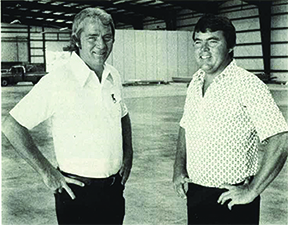
A tourist walks into a bar and asks for a Bud. Bartender hands him a bottle of Miller.
“I asked for Budweiser,” man says.
“That is Budweiser,” replies the bartender.
That exchange used to happen on a regular basis in Fort Lauderdale, especially in its busiest neighborhood bars. The reason: William Thies & Sons, the local Miller Beer distributor, had developed such a close relationship with its best customers that a number of bars did not even carry Budweiser. Back in the 1960s, when Budweiser was the dominant beer in most of the country, it failed to keep pace with local customers’ needs when the crush of college spring break caused bars to run out of product and need a resupply fast.
When Budweiser was slow in response, William Thies & Sons made sure that Miller was available during the busiest times. Some of the most popular bars rewarded that service by refusing to carry its rival.
Bill Thies, who as a young man built that remarkable relationship after he took over the business when his father died suddenly at age 53 in 1964, died Tuesday at age 80. He had been in failing health for several years and did not recover from the effects of pneumonia over the Christmas holidays.
Thies and his brother-in-law, Bob Blaikie, were a Mr. Inside and Mr. Outside team. Blaikie was at the company plant in Wilton Manors, watching the books and keeping the trucks rolling. Thies was mostly on the outside, knowing the customers and expanding the company’s business. His friendly nature and big personality made him a natural salesman, and one of the best known figures in the bar and restaurant industry. He was on a first-name basis with countless bar owners and their staffs.
“My father never told me I couldn’t enjoy my job,” he liked to say.
The company’s market was large, stretching from Broward County to Vero Beach. Thies’ younger brother Dennis, known as Dee, ran the business north of Broward County. The company had a second distribution center in Lake Worth. It eventually expanded to include distributorships in Fort Myers and Sarasota. The brothers (Bill is on the left) are shown in a photo that first appeared in Gold Coast magazine in the 1970s, and was repeated in the magazine’s 50th-anniversary issue in 2015.
It did not hurt the business that the Thies family was well connected in Fort Lauderdale. The family came to Florida from Washington, D.C. in 1948 and got the Miller franchise in 1951. Bill attended St. Anthony School and Central Catholic High School (now St. Thomas Aquinas) where he was a three-sport athlete. He attended Notre Dame for two years and left when he married and joined the army. He was 26 when he took over the family business.
The company capitalized on the popularity of Miller Lite in the 1970s. Before it was sold in 2001, it had expanded to carry numerous brands, including Heineken beer. Thies had seven children and was joined in the business by his sons, Bill Jr. and Jim, who also joined him in real estate investments. A daughter, Krista Marx, is a judge in Palm Beach County. Other family members live in South Florida and Hawaii.
In retirement he became a private investor. He and his son Bill were shareholders in Gulfstream Media Group, publisher of Gold Coast magazine, when the company reorganized in the mid-1990s. Among the real estate investments was a Christmas tree farm in Blowing Rock, North Carolina.
A funeral mass will be held at 11:30 a.m. on Tuesday, Jan. 30 at St. John the Baptist Church in Fort Lauderdale. In lieu of flowers, contributions may be made in Bill’s name to the St. Anthony Friends for Education, 920 NE Third St., Fort Lauderdale, online at saintanthonyschoolfl.org/give-now-2/ or call 954.467.9009.
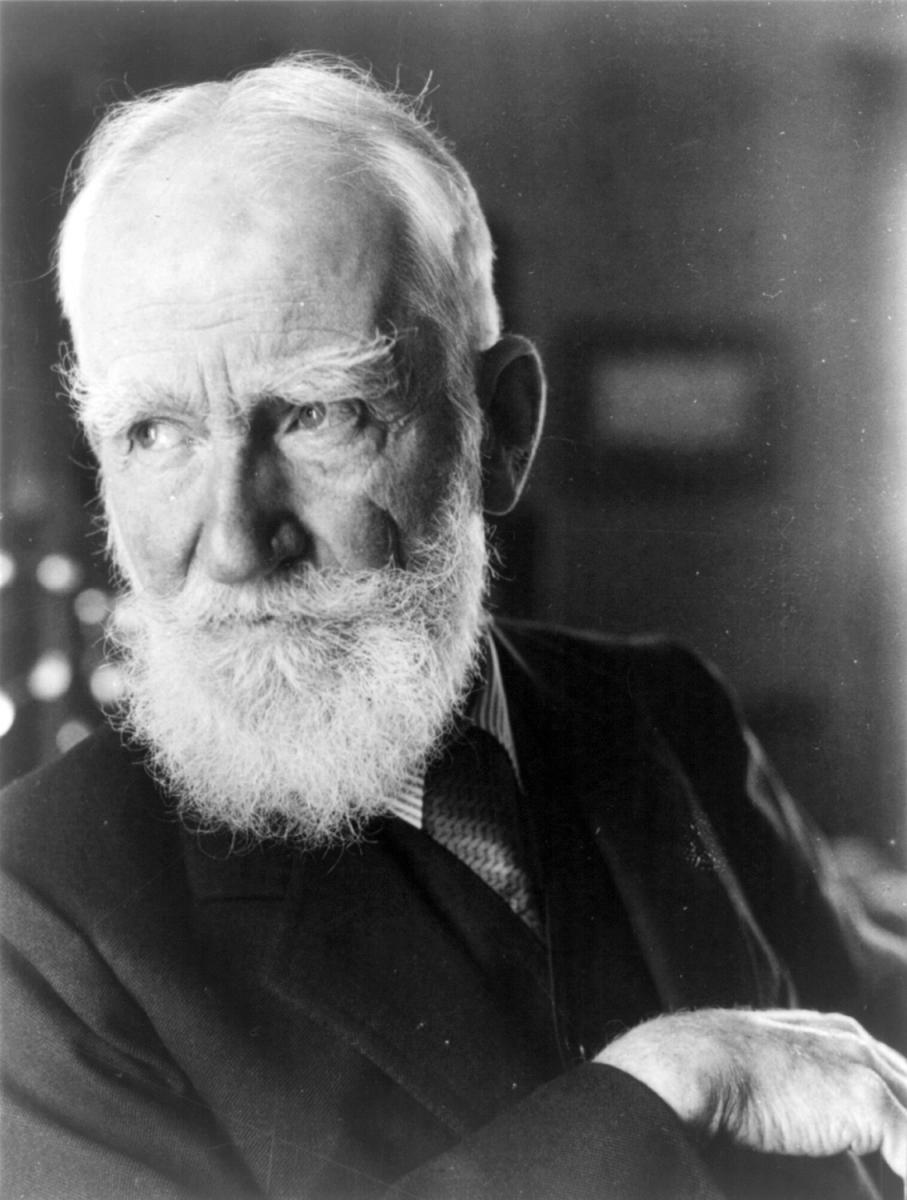
Our latest project, with the working title "All The President's Women," will be groundbreaking for its use of language. We plan to set a record for dirty words. That is going to be a challenge, for in the last few years words we would not use outside of locker rooms—and men’s locker rooms at that—have become commonplace in the media, including national television.
Not long ago certain expressions for bodily functions, or places where they normally occurred, were considered vulgar. You bloody wouldn’t use them when being introduced to the queen. But in recent years they have become bloody common, almost to the point that they are losing their shock value.
Which brings us to the word “bloody” and the memories of the best teacher we ever had. His name was Dan Rodden. He taught English at La Salle and began every course by spending the first two weeks dissecting word by bloody word a definition of art. “Art is intellectual recreation achieved through the contemplation of order.”
It would take us two weeks to repeat those lectures, so let’s move on. Dan Rodden ran our college theater, which was strong in musicals and at one time had quite a nice little reputation in Philadelphia. After rehearsals, he went drinking with his student performers, which meant he sometimes felt and looked bloody awful in the morning. It was a mood he carried into the classroom. With that being said, he was a delightful teacher and the man who first explained to us that when vulgar language becomes too common, it loses its shock value.
In teaching a course on theater, he mentioned a George Bernard Shaw play. We forget which one, but it was probably “Pygmalion,” which decades later inspired the musical “My Fair Lady.” In it, a character used the word “bloody.” Rodden pointed out that at the time (1913) the word was never used in polite British society. Rodden said this was like using the word “s**t” in our time. Our time, of course, being the1950s. It shocked the British audiences and helped mold Shaw’s image as a literary rebel.
That revelation amused us, as it still does most people in the U.S. Here, the word is regarded as just another example of British slangish, like “bloke” or “mate.“ But it still is regarded in Britain and parts of Australia as rather lowlife and used only by the culturally inadequate.
And so it may be with some of the crude words, now emanating from Washington sources that are increasingly polluting our national discourse on events, and in venues that deserve more refined expression. Which is why we need to come up with all the bad words we can think of and put them in a single historical source. And use them while they’re still bloody good and dirty.
Image via
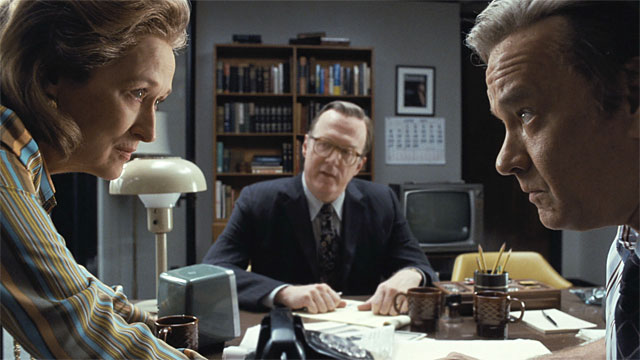
“The Post” is a movie that could not miss being a winner. Not with Steven Spielberg directing two of the best actors of our time—Tom Hanks and Meryl Streep. It doesn’t hurt that the story is an important piece of journalism history, and part of a genre ennobled by a classic—“All The President’s Men.”
Aside from its artistic value, what we appreciate about this film is its timing. It makes every serious journalist, especially newspaper people, proud of their calling. It validates, almost to the point of glorification, a profession that has been shamefully attacked by that miscreant in the White House, whose actions have been affirmed by the scummiest of his political associates and by that paragon of fake news called Fox News.
As journalism history, critics have observed that the film gives too much credit to The Washington Post for exposing the Pentagon Papers, somewhat downplaying The New York Times, which owned that story and won a Pulitzer Prize for its work. Nonetheless, it is excellent drama and should do for the Pentagon Papers what “All the President’s Men” did for Watergate.
The latter film appeared shortly after Watergate took down a president, yet until the movie brought it all to life, a lot of people had difficulty understanding what all the fuss was about. To many, it seemed like just another political dirty trick gone wrong. The Pentagon Papers incident pre-dated Watergate and for most people it was also a vague affair, relating to a war that people just wanted out of, anyway we could.
But it was hardly a unanimous sentiment. Many of us had been through years of brainwashing, going back to the French defeat in North Vietnam in 1954, afraid that if South Vietnam went Communist, all of Southeast Asia would soon follow. The “domino effect” was a concept people could grasp. It was easier to understand than a nationalist movement, which was affecting countries that had enjoyed European civilization for hundreds of years. It was inconceivable in the early 1970s that one day American veterans would return to Vietnam as tourists and be warmly greeted by those who once tried to kill them.
The Pentagon Papers are more readily understood with the perspective of four decades and the reality of a war that has been brought home numerous times in books and films such as “The Deer Hunter,” “Platoon” and “Apocalypse Now” and its memory hardened in granite on the National Mall. That wall is a reminder of an afternoon in 1969 in a cemetery just outside Philadelphia when an honor guard of his friends, still in uniform, lowered Lenny Martin to his grave, and the sun suddenly burst through on a day that had been wet and gloomy.
What Daniel Ellsberg revealed when he leaked the Pentagon Papers is that Lenny Martin and more than 50,000 others had died in vain and that the government suspected it all along. In that respect “The Post” goes a bridge too far. It lumps four presidents, going back to Eisenhower, as sort of conspirators who deceived the American people on the reality of that war. That is unfair to at least one. Although he initially sent in American forces as military advisors, President Kennedy was on record as a young senator in the 1950s to the effect that European colonies, such as the one France had, were doomed. As president, he had begun to realize that further military involvement was a mistake. After the Bay of Pigs disaster in 1961 and the tension of the Cuban Missile Crisis a year later, he had lost confidence in the CIA and some of our highest-ranking military men. He told confidants that he planned to withdraw from Vietnam after he won re-election. He also angered the military-industrial establishment by reaching out to the Soviet Union in an effort to end the Cold War.
As with the Pentagon Papers, time can be history’s clarifier, and it is increasingly clear that John F. Kennedy was one more casualty of Vietnam
Image via
There are at least 30 local magazines in the same Florida markets (Gold Coast and Treasure Coast) that once had only a few. It is doubtful that many of them would exist today had it not been for the example set in Philadelphia some 60 years ago. That was when an obscure publication called Greater Philadelphia Magazine began to evolve into the first important city magazine, virtually inventing a new media form that has been copied in hundreds of cities, large and small.
Greater Philadelphia dropped the Greater in the mid-1960s, and as Philadelphia it cast the mold for what are now important media voices such as New York magazine, Washingtonian and Texas Monthly, as well as less punchy magazines all over the country. In our lifetime only a few people can claim to have invented something new in the print communications field. Jimmy Breslin, who died in March, was one. He created the “news column”—applying the license and artistry of a columnist to the leading news stories of the day. D. Herbert Lipson, who died Christmas morning, was another (shown above on the right with Alan Halpern in the late 1950s). He is the man who invented the city magazine.
Well, to be historically accurate for the dwindling number of people who care about such things, he should be termed co-inventor. For Herb Lipson, fresh out of Lafayette College, joined his father’s company at almost exactly the same time as Alan Halpern. And many people who worked for him, including this writer, considered Halpern, a gifted editor, as the man with the vision to turn a Chamber of Commerce organ into a groundbreaking magazine.
But, as we pointed out in our bookazine, “The Philadelphia Magazine Story,” which published in 2013, the writer most influential in Philadelphia’s dramatic growth in the 1960s, thought otherwise. Gaeton Fonzi, who joined the magazine in 1959, wrote most of the blockbuster stories that built the magazine’s reputation throughout the next decade. He recalled that it was Lipson who pushed for the transformation of a publication, which survived by selling its cover as advertising into a hard-hitting, must-read magazine.
He encouraged Fonzi to do the first stories that attracted new readers as the magazine grew in a few years from a free distribution of 15,000 to a paid circulation of nearly 100,000. As we wrote several years ago: “Lipson had a vision of what the magazine could become and the sense to give Halpern largely a free hand, and to support him in running stories that took considerable courage and exposed him to legal risk.”
Those stories included the expose of a crooked reporter at The Philadelphia Inquirer who used his reputation as a hatchet man for the paper’s feared publisher, Walter Annenberg, to shake down numerous businesses, including the city’s largest bank. That story landed the reporter in jail, where he died. It also led to Fonzi’s book on the disgraced Annenberg, which appeared to prompt him to sell the paper to Miami-based Knight-Ridder a few years later.
By that time Herb Lipson had expanded to Boston, where Boston magazine still thrives. That was actually our idea, and we helped him launch it at the same time we were preparing a move to Florida.
Fonzi, who later joined us in Florida and was editor of Miami Magazine in the 1970s, also began his acclaimed work on the Kennedy assassination at Philadelphia. He interviewed Arlen Specter, then an assistant district attorney, shortly after the Warren Commission published its controversial finding that a lone assassin killed JFK. Specter had received considerable publicity, initially favorable, for his work on the Commission. To Fonzi’s amazement, Specter, later at U.S. Senator, could not explain his own theory of the “magic bullet” that underpinned the lone gunman conclusion.
Our first journalistic assignment in Florida was made in the company of Herb Lipson. We stayed at the Boca Raton Resort and Club and met with the former publisher of the defunct Philadelphia Record at his Palm Beach home. J. David Stern was celebrated for shutting down his paper after a newspaper strike by the very union he had helped create. Lipson was known for taking such fun trips with writers. He had more than a little playboy in him in his early years, manifested on that trip when he insisted we visit Fort Lauderdale to check out the sexy girls at a restaurant called the Mai-Kai.
He later spent the last of his 88 winters partly in Florida in the Naples area. When Gold Coast celebrated its 50th anniversary in 2015, we invited him over for the event. We thought it would be fun to introduce the man who started it all. He politely declined, saying we would meet at another time.

The release of the long-sealed files on the murder of President Kennedy has produced little new information. Those of us (we few, unhappy few band of doubters) who have been following this cover-up of a presidential assassination for the last 50 years, were not actually expecting to find a file labeled: “How We Knocked Off A President and Got Away With It.” The people who committed this crime have had ample time to make sure no incriminating documents survive.
However, one interesting detail long known to those who have studied the crime was reinforced. Documents make it clear that within days of the assassination Lyndon B. Johnson’s White House and Robert Kennedy’s attorney general’s office wanted to be sure that Lee Harvey Oswald alone be blamed for the crime. They may have had different motives, but for both, it was a priority that any talk of a conspiracy be immediately squelched. The Warren Commission’s job was to do exactly that. And it did.
Still, it is puzzling that some parties still object to releasing all the documents relating to JFK. And those they have released are teasers. They tend to have crucial parts missing, especially references to the CIA and other aspects of our intelligence network. Researchers think those withheld documents may confirm that Oswald was both a CIA and an FBI operative, which shatters the Warren Commission portrait of him as a pro-Castro communist sympathizer. It also supports the principal conspiracy theory: Oswald was a “useful idiot” whose role was to take the blame (and a bullet) as part of a high level government hit.
If one thinks the refusal of government sources to give up documents to the public is something of the past, think again. And listen to Dan Christensen. Christensen (above) is the founding editor of Florida Bulldog, an independent news organization whose work is often picked up by local papers. He is a former Miami Herald reporter. Florida Bulldog celebrated its eighth anniversary last week with a party at YOLO on Las Olas Boulevard.
For six of those eight years Christensen has been waging a campaign to get the FBI to release what it knows about a Sarasota Saudi Arabian family that was visited by some of the 9/11 hijackers prior to the 9/11 attacks—perhaps the only event to compare to the Kennedy Assassination, and infinitely greater in the death toll.
The Sarasota Saudis were connected to the Saudi royal family and disappeared in a hurry (they left their cars and other belongings) shortly before 9/11. The obvious questions: Were Saudi royals behind the 9/11 attacks? Does our government know it? Did they conceal it?
The FBI never told the 9/11 Commission about the Sarasota Saudi connection, which has angered former Florida Sen. Bob Graham, a member of the commission who has been working with Florida Bulldog to find out why such dramatic information was concealed. Slowly, and only with constant legal pressure, has it been revealed that the FBI had a report on the matter, but never told the 9/11 Commission, and has for six years resisted the efforts to make it come clean. Christensen likens it to the Kennedy Assassination files.
“It’s worse, if that’s possible,” Christensen says. “Say what you want, one thing the Warren Commission did was they laid everything out. There were 26 volumes of evidence, and nothing was blocked by black tape. It was all there. But now (on the Saudi matter), very little is laid out, and there is no documentation. Much of it is being held for a variety of reasons. It’s a completely different ball game.”
“We see that lies have been told,” Christensen adds. “It’s what Bob Graham calls ‘aggressive deception.’ They [The FBI] are actively lying to us since 2011. First, they said they notified Congress [about the Sarasota Arabs]. Well, we have demolished the argument that they told Congress. We found documents in their files that showed there were many connections between the Sarasota Saudis and the hijackers.”
Florida Bulldog has lived up to its name with its dogged legal efforts, resisted by the government at every turn. Bulldog has been seeking information, which is redacted in the FBI files that have been released, especially those concerned with funding for the 9/11 terrorists. Christensen thinks that ties in with the Sarasota Arabs and their contacts with the hijackers.
There is an interesting connection between Florida Bulldog’s quest and the JFK assassination researchers. The Sarasota matter first came to Christensen’s attention through an Irish investigative reporter, Tony Summers. That’s the same man who was friendly with our late colleague, Gaeton Fonzi, whose The Last Investigation is regarded as one of the best books on the Kennedy Assassination.
Summers, who wrote his own book on the assassination, was influenced by Fonzi’s work in the early 1980s. It was after Fonzi’s book first appeared as two long magazine articles in Gold Coast magazine.
Fonzi was in contact with Summers until his death in 2012, and his widow Marie continues that connection.
She and Summers are among the more prominent of the club of "we few, unhappy band of doubters."

One of our communicants is a great fan of President Trump. He admires him for saying what he means and doing what he says, for his military service while in high school, as well as his respect for women and Puerto Ricans. He also enjoys football, but had a power failure and missed the big game. He called to find out who won.
“Miami won, 41-8,” we said.
“Shut up. You must mean Notre Dame won 41-8.”
“No, Miami.”
“That’s impossible. God would not allow it. How do you know?”
“Saw it. Besides, it was in the papers.”
“It must be fake news. You can’t trust the media. They’re the enemy of the people. Where did you see it?”
“It was in The New York Times.”
“Oh, it’s definitely fake news. They never tell the truth. Who really won?”
“It was also on Fox News.”
“It was. My God, it must be true then. How could it happen?”
“Easy. Miami wore their good old orange jerseys and traditional white helmets, and Notre Dame stunk up the joint. It could have been the other way around, except for about a dozen plays.”
“Did Sean Hannity confirm this?”
“Haven’t heard. I know he’s been busy with that child molester fuss, or something.”
“What’s that all about, anyway?”
“Guy running for office in Alabama. They say he likes teenage girls.”
“Who doesn’t?”
“Some like teenage boys.”
“Some like Foxy girls. Until they sue.”
“Some like both. Anyway, that’s the real score.”
“You mean the game?”
“Alas, yes. God’s will be undone.”
Image via

The addiction known as Notre Dame is returning to South Florida to play UM in a game that is as of old—a clash between two highly ranked teams that could bear on the national championship. Although the game is at home for the Hurricanes, it isn’t much of an advantage, for Notre Dame has a powerful following in South Florida. Hell, it has a powerful following all over the country, wherever faith and football intersect. Still, there aren’t many markets so distant from South Bend that have so many influential alums in residence. And all, needless to say, are football fans.
You can start with Fort Lauderdale Mayor Jack Seiler, but the Irish connection goes back long before Seiler was born. Consider Governor R.H. Gore, who came to Florida in the 1920s and built the newspaper now known as the Sun-Sentinel. Gore (who was governor of Puerto Rico, not Florida) did not go to college, but he lived in Indiana and was a Notre Dame admirer. He sent six of his nine children to Notre Dame, and members of more recent generations have followed. He died in 1972, at a time when his sons Jack and Ted Gore were top executives at the newspaper.
By then local athletes had become part of the Notre Dame football lore. Longtime U.S. District Judge William Zloch was a quarterback under legendary coach Ara Parseghian in the 1960s. Before that he was in the same backfield as the storied Brian Piccolo at Central Catholic, now known as St. Thomas Aquinas, a nationally recognized high school football power. His two brothers, Chuck and Jim, also played football for the Irish.
They were contemporaries of Notre Dame alums who starred for the young Miami Dolphins when it became pro football’s only undefeated team. Linemen Bob Kuechenberg and Nick Buoniconti both had distinguished Florida careers after football.
A number of local players have followed their path, notably Autry Denson, from Nova High School who became Notre Dame's all-time leading rusher. After several years in the pros, he began his coaching career here on a high school level. Denson is back at Notre Dame coaching running backs.
Football isn’t the only sport associated locally with the Golden Dome. The late Jimmy Evert was captain of Notre Dame’s tennis team before he became a noted South Florida coach, whose star pupil was his daughter Chris.
ND grads are found all over the South Florida business world. One of the area’s oldest retailers, men’s clothier Maus & Hoffman, had three Notre Dame brothers working together—Bill, Tom (deceased) and John—along with a few members of the next generation. Bob Moorman, Notre Dame ‘73, heads another old Las Olas retailer, Carroll’s Jewelers. Anyone hungry for more can go to any of the chain of Quarterdeck restaurants, owned by Paul Flanigan, another grad from the 1970s.
Notre Dame has an unusual presence in local publishing. Aside from the Sun-Sentinel history, three of the leading South Florida magazines have had Domers (as in golden dome, above) as chief executives. The late Ron Woods was the owner of Palm Beach Illustrated; John Shuff is owner/publisher of Boca Raton Magazine; and Mark McCormick is president of Gulfstream Media Group, which publishes six titles, including Gold Coast magazine.
Notre Dame clubs (there are five in South Florida) are about much more than football. They raise scholarship money and support local charities. Their local dinners are invariably well attended, and football isn’t their only draw. They are present in numbers when the Notre Dame Glee Club makes its periodic trips to the area. The singers’ next visit comes up in March. You know the Irish will turn out for their famous fight song—especially if they win Saturday.
Image via

Recall the scene from “Gone with the Wind” when an older couple sees the names of their sons listed among the dead following a big Civil War battle? The posting of the dead and wounded in such public places as train stations was common in the Civil War because that’s where the telegraph offices were located. It was one of the more realistic touches in a film that had its share of romantic license. The newspapers picked up their information on casualties that way, or from dispatches from their own correspondents posted with most units.
We learned that some years back when visiting the national archives to try and get information on our Gallagher ancestors, John and James. They were our great grandmother’s younger brothers, and the family history says simply that they died in the Civil War. No dates or battle information has come down. We think they lived near Easton, Pennsylvania, for that is where their sister was married in 1854. Census records show two young Gallagher men with the right names living in an Irish shantytown along the Lehigh River in 1860. Are they our boys? We will likely never know. There were 120 men in the Civil War from Pennsylvania with the names John or James Gallagher.
At the archives we discovered that aside from unit records, such as payroll, pension and discharge papers, little information about the average soldier existed. There were no home addresses, next of kin, etc. We asked a worker at the archives how the government notified families when men were killed. He said the government did not. Newspapers, which were with the units in battle, sent that sad information home. Unless a family saved such materials or kept letters from soldiers or their friends, many of those lost in battle were gone with the wind.
But the face of battle has changed.
Witness the recent deaths of a Florida soldier and three comrades in Niger. It led to a controversy over President Trump’s condolence message to the wife of the Florida man. There have been demands for information on the circumstances of his death—looking for someone to blame. The government is right to be cautious in revealing that kind of stuff about what is obviously a sensitive and necessarily guarded anti-terror mission.
The young widow complained that she was not permitted to see her husband’s body. There is a good reason for that. We have previously written about covering a Vietnam funeral when we were able to sit in on the instruction class at Dover Air Force base for soldiers assigned to escort bodies home for funerals. The escorts were told that if a body were listed as “non-viewable” it meant exactly that. They were told that there were women in mental institutions because they insisted on seeing a body of a husband or son disfigured beyond recognition. If the family insisted on opening the casket, the escorts were told to leave the room.
Such has been the intensity of the focus on the recent deaths that some have wondered if the Florida soldier could have been killed by friendly fire. That stems from the case of former pro football player Pat Tillman who was killed in Afghanistan. It was not initially revealed that he was probably killed by our own troops—as if that is some kind of crime. Hardly. Men have killed comrades in the fog of battle since wars began. A notable case was Gen. Thomas (Stonewall) Jackson, fatally wounded in the dark by a Confederate sentry during the battle of Chancellorsville in 1863. Such friendly fire deaths are rarely documented, and sometimes it takes years. In a case in our family, it was about 70 years before we learned that our cousin, Lt. Thomas McCormick, a Navy pilot who died at Iwo Jima in 1945, was likely such a victim.
We learned that in the strangest way. As far as we know, Tommy’s mother in Atlantic City (his parents were separated) received only the usual “missing in action” telegram. We don’t think his commanding officer, or any friend, ever contacted her with more information, which usually happened in World War II. Tommy flew the OS2U Kingfisher, a floatplane launched by catapult from the battleship Tennessee. His job was to fly at low altitude to observe fire for the ship’s big guns, which were supporting the Marines’ landing. The ship’s log, which we did not check out until years later, noted that his plane was seen crashing with its tail section missing. There was no explosion in the air or enemy planes that could have shot it down.
A few years ago we contacted Paul Dawson, who runs the U.S.S. Tennessee Museum in Huntsville, Tennessee. To our amazement he knew who Tommy McCormick was and had photos of him in his aircraft (above). It turns out Dawson’s father had been the ship’s photographer, and he saved photos of the handful of pilots on the battleship. He knew them because he sometimes did aerial photos from their planes. Knowing of our interest, Paul Dawson subsequently discovered information that cast light on Tommy McCormick’s last flight.
He discovered an after-battle report marked “confidential,” which human eyes had probably not seen for seven decades. It was secret at the time for obvious reasons, for it told what had gone right and wrong aboard the ship at Iwo Jima.
The report said that a “projectile” had been seen striking Tommy’s aircraft, breaking it in two without exploding. Then, in the closing summary came this revelation: It was possible Tommy’s plane was hit by a large shell from one of our own ships firing at a higher angle than expected. It would have gone through the small plane flying at low altitude without exploding.
From what we know of the military, if the Navy suspected that friendly fire downed the plane, it probably was pretty sure that’s what happened.
Such is the fog of war, even on a clear day in February 1945.

The most recent Ken Burns documentary on the Vietnam War is a much-acclaimed history of an event that most Americans may never fully understand. Unlike recent controversies about Civil War memorials, a war with which no one alive today has personal experience, there are millions who lived through the several decades when Vietnam evolved from a place vaguely known as French Indochina to an epic tragedy for hundreds of thousands of Americans, and for those who fought against us.
For most, Vietnam began in the mid-1960s when our military presence grew from a few Special Forces and advisors to hundreds of thousands of soldiers. But the roots of that conflict trace back to 1954 when the French were defeated at Dien Bien Phu. Most of us took little notice, for we were just getting over the Korean War.
But not long after, the name Vietnam became better known, thanks to an ex- Navy doctor-turned-medical missionary named Tom Dooley. Dooley wrote and spoke of Vietnam in terms of savage communists versus persecuted Catholics. He was a Catholic product of Notre Dame (although he never graduated), and he toured many colleges in the U.S. pleading his cause, which we now know was exaggerated and controlled by the CIA. College girls, in their knee socks and saddle shoes, loved the good-looking, eloquent Dooley. They did not know he did not fancy girls.
Dooley’s influence, largely forgotten today, was strong. He had a powerful friend in New York, Francis Cardinal Spellman, who in turn was close to the Kennedys and other prominent American Catholic families. Working with the CIA, he managed to seed our Vietnam involvement with the first of the distortions that would characterize our government line for the next 15 years. He made an anti-colonial nationalist movement seem to be a communist assault on western values, including the Catholic church.
Dooley did not live to see the results of his work. He died at 34 in 1961, at a time when the U.S. was barely involved in Vietnam. President Kennedy was much more focused on a nearer problem: Cuba. But we now know that even as he sent military aid, JFK was wary of a larger U.S. involvement in what he perceived as part of an anti-colonial movement that had swept Southeast Asia since World War II.
Initially, most Americans, myself included, supported U.S. policy. We were all brainwashed. I was also in the military, sort of. I had been commissioned through ROTC in the late 1950s at a time when the Army had too many junior officers and no war for them to fight. Many of us were given six months active duty and eight years in the reserves. Although trained in artillery, I was in a civil affairs unit. Our job would be to rebuild cities after we destroyed them. We were a wonderful group of screw offs, useless in peacetime. I wrote stories about our annual summer camps with titles such as “The General’s Martini,” “The Night We Boiled the Major” and “Can’t Anybody Here Hit That Deer?” We had so much fun that nobody ever quit our outfit.
Still, we would have made an effective active duty unit. We were heavy with brass. Our commanding officer was a state senator and we had abundant political connections, with lawyers, doctors, stock brokers, a Mercedes-Benz dealer, a college professor, a du Pont engineer, a labor relations specialist, service station owners and two journalists who would wind up in the magazine business together in Florida. Some of the older guys had combat experience in Korea. We thought Vietnam could use our myriad talents in pacifying all those Viet Cong villages. The army thought otherwise. When the war was getting hottest, they threw our whole unit out of the army. But my reserve obligation was up by then.
I had left sports writing for the real world, and in the next few years wrote about the growing war, even as my opinions subtly shifted. “War Boom” was a column about the Boeing Vertol plant near Chester, Pennsylvania, that was building the big Chinook helicopters still used today. One day a proud father came to the newspaper with his son who was a devout Christian and was joining the army despite all the noise being made by un-patriots whose protests were growing every year. The kid was no John Wayne; he seemed on the frail side and not intellectually gifted, but I wrote that the father wanted the world to know that his boy was doing his duty. Only years later did I learn the kid had been killed in Vietnam.
By then I was at Philadelphia magazine, where I went to Toronto on a story called “The Exiles” about local young men who had left the country to avoid the draft. Another piece, “A Welcome to Arms,” described the induction center where dozens of fresh-faced draftees gathered to begin their journeys to boot camp at Fort Jackson, South Carolina. I also did a piece about the status of our military reserves, which ranged from screw off units such as ours, to Air Force reservists who left jobs on a Friday afternoon, flew giant transports 8,000 miles to Nam, and were back in the office Monday morning.
By 1967 it was clear that most Americans were barely touched by a war that was affecting more and more families in a terrible way. We decided to do a short moody piece on the caskets coming home from the war. It turned out they did not come to the Philadelphia airport, but rather to the Air Force base at Dover, Delaware. The idea enlarged to covering a Vietnam funeral. We checked the papers for the daily casualty reports. After being coldly rejected by the first few families we called, we found a father who seemed to think he had an obligation to accommodate the media. And it turned out, the dead soldier was a friend of the younger brother of one of my college buddies. He and a dozen friends had enlisted together in various services. Four of them got to Vietnam and three came home without a scratch. The fourth, Pvt. Leonard Martin Jr. was killed in a mortar attack at an artillery post called Gio Linh.
We followed the process all the way from sitting in on the instructions they gave at Dover Air Force base to “escorts”—the soldiers assigned to accompany the casket to the funeral. They were told to be respectful and not tell any war stories. You were not there. Keep your mouth shut. Lenny Martin’s escort was a kid from Kansas. He did a great job.
The remains were delayed returning from Vietnam. We hung around, waiting with the family for a week. The magazine was mostly printed by the time of the funeral. It had not seemed a terribly sad event until that afternoon when people, many of them young, who had all seemed stoic, suddenly broke down en masse when the honor guard, including several of the friends who had enlisted with Lenny Martin, fired the 21-gun salute, and the young escort from Kansas presented the carefully folded flag to Martin’s mother with the reverent words “On behalf of a grateful nation.” It had been drizzling all day, but as the mourners returned to their cars to leave and the gravediggers began to lower the casket, the sun suddenly burst forth and the gray day turned freshly green and reborn.
“Back From Vietnam” was a first of its kind. Philadelphia magazine had a dramatic flag draped casket on its cover. Within weeks, publications around the country were covering Vietnam funerals. A war, which had for years seemed as distant as the names Tom Dooley and Indochina, had finally come home.
We visited the Vietnam Memorial Wall to make sure Lenny Martin was on it. He was, along with 58,318 others, most of who were barely born when Tom Dooley first made his misguided case in the 1950s.
There is one other name that should be added to that memorial. John F. Kennedy. There are numerous testaments by sources close to JFK that he thought Vietnam was a losing proposition and intended to withdraw American forces after the election of 1964, an election he did not live to see. Few recall that Kennedy had seen Vietnam first hand as a young congressman. In 1951 he visited the country and came home convinced that “in Indochina we have allied ourselves to the desperate effort of a French regime to hang onto the remnants of empire…”
JFK, his distrust of the CIA growing from the 1961 Bay of Pigs disaster until his murder in 1963, also sought to ease tensions with the Soviet Union over Cuba. Elements of our government, including powerful military and industrial figures, wanted just the opposite. They wanted, and eventually got, a bigger war in Vietnam. Some were willing to risk a nuclear war at a time when we could still win it. They saw President Kennedy as a traitor.
There is a growing body of opinion, of which this writer is a committed advocate, that it cost JFK his life. He is every bit as much a war casualty as those 58,318 names etched on that cold black granite memorial.
Image via
